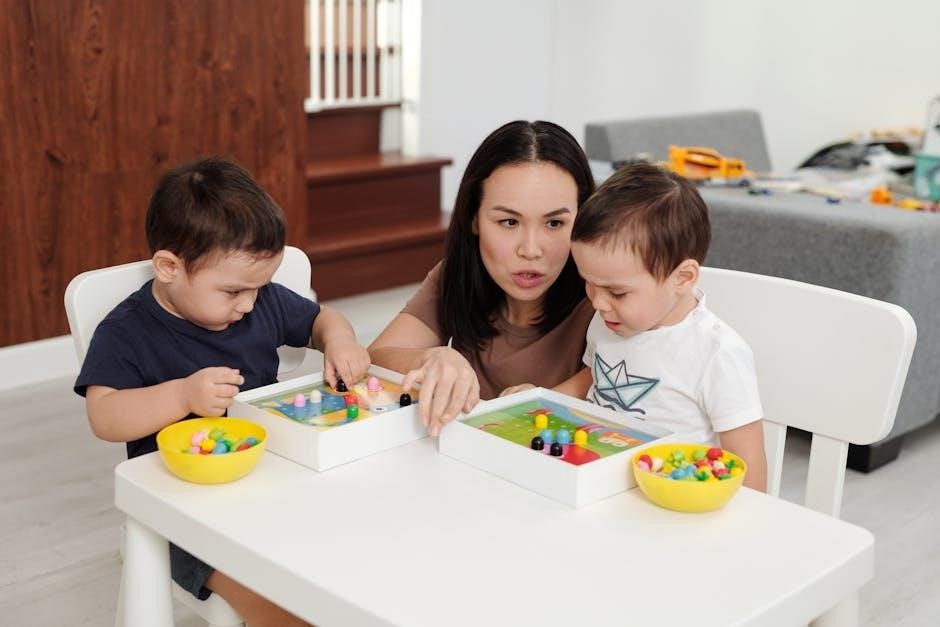Initiating the Conversation: Tips on How to Talk to Your Parents About Downsizing
Initiating the conversation about downsizing with your parents requires empathy and tact. Start by expressing your concerns for their well-being, emphasizing how downsizing can simplify their life and reduce stress. Approach the topic gently, avoiding pressure, and frame it as a positive step toward a more manageable lifestyle. Be prepared for resistance and listen to their feelings, ensuring they feel heard and respected throughout the process.
1.1. Be Emotionally Prepared
Be emotionally prepared for the conversation, as downsizing can stir strong feelings. Acknowledge the sentimental value of belongings and the lifestyle change. Approach with empathy, allowing your parents to express their emotions. Start early to avoid rush and stress, ensuring patience and understanding guide the process. A calm demeanor fosters a positive dialogue.
1.2. Highlight the Practical Benefits
Emphasize how downsizing can reduce maintenance, lower costs, and simplify daily life. Focus on the freedom from yard work, repairs, and clutter. Highlight the financial benefits and the opportunity to focus on essentials, creating a more comfortable and manageable living environment for your parents.
1.3. Frame it as an Opportunity
Present downsizing as a chance for a fresh start, emphasizing the freedom to focus on hobbies, travel, or new interests. Highlight how it can lead to a simpler, more organized lifestyle, allowing your parents to enjoy a clutter-free and less stressful living environment tailored to their needs.

Acknowledging the Emotional Side of Downsizing
Downsizing can be emotionally challenging, as it often involves letting go of cherished items and memories. Recognize the sentimental value of belongings and approach the process with patience and empathy, respecting your parents’ attachment to their possessions and the memories they hold.
2.1. Understanding the Sentimental Value of Belongings
Recognizing the emotional significance of possessions is crucial. Each item may hold memories or represent a part of your parents’ history, making it difficult to let go. Validating these feelings fosters understanding and respect, allowing them to process their attachment with empathy and patience.
2.2. The Importance of Patience and Empathy
Patience and empathy are vital when helping your parents downsize. Acknowledge their emotional attachment to belongings and allow time for reflection. A supportive and understanding approach fosters trust, making the process less stressful and more collaborative, while respecting their feelings and memories.
2.3. Celebrating Memories While Letting Go
Celebrating memories while downsizing involves acknowledging the emotional value of items. Take photos, create memory albums, or share stories to preserve memories. Involve family to make it a bonding experience, ensuring cherished moments are honored while simplifying their space. This approach fosters a sense of closure and makes downsizing a meaningful transition toward a simpler, more organized lifestyle.

Practical Strategies for Downsizing
Start early, break tasks into smaller steps, and focus on less sentimental areas first. Use checklists or professional organizers to streamline the process and stay organized.
3.1. Start Early to Avoid Rushing
Starting the downsizing process early helps reduce stress and allows time to assess each item without pressure. Begin with non-sentimental areas to build momentum and gradually tackle more emotionally charged spaces, ensuring a smooth transition and thoughtful decision-making throughout the journey.
3.2. Break Down the Task into Smaller Chunks
Divide the downsizing process into manageable tasks, such as organizing one room or area at a time. Set realistic daily goals, like sorting through one drawer or shelf, to maintain progress without feeling overwhelmed. This approach helps build momentum and keeps the process less daunting and more achievable.
3.3. Focus on Less Sentimental Areas First
Start with areas like the garage or attic, which hold less sentimental value, to reduce emotional strain and build momentum. This strategy helps your parents gradually adjust to downsizing without feeling overwhelmed by emotional attachments early on. By beginning with these spaces, you create a sense of progress and set a positive tone for the entire process.

Sorting and Decluttering: A Systematic Approach
Sort belongings into “keep,” “toss,” or “donate” piles, focusing on practicality and future needs. Start with less sentimental areas to ease into the process. This systematic approach ensures progress and reduces overwhelm while maintaining organization and clarity throughout the downsizing journey.
4.1. Categorizing Items into Keep, Toss, or Donate Piles
Start by sorting items into three piles: “keep,” “toss,” or “donate.” Focus on practicality and future needs, ensuring each decision aligns with your parents’ new lifestyle. Involve them in the process to respect their feelings and memories, fostering a collaborative and respectful approach to decluttering and downsizing their belongings effectively.
4.2. Setting Realistic Daily Goals
Set achievable daily goals to avoid overwhelm, such as organizing one shelf or decluttering a small area. Celebrate progress, no matter how small, to maintain momentum and motivation. This approach helps manage the process effectively while respecting your parents’ physical and emotional limits, ensuring a stress-free downsizing experience.
4.3. Evaluating Duplicate Items
Gather duplicate items, assess their condition, and keep only the most functional. Discard or donate extras to reduce clutter. This helps create a more organized and manageable living space, making downsizing smoother for your parents while ensuring they retain what truly serves their needs.

Handling Sentimental Items
Handling sentimental items requires empathy and creativity. Consider creating a memory box or digitizing cherished items to preserve memories while downsizing, focusing on a few meaningful keepsakes, such as photos or heirlooms.
5.1. Preserving Memories in Creative Ways
Preserving memories creatively involves digitizing photos, creating memory boxes, or crafting scrapbooks. These methods allow your parents to cherish memories without keeping every item, celebrating their history while letting go physically, ensuring emotional connection remains intact in a meaningful way.
5.2. Honoring the Emotional Journey
Honoring the emotional journey involves allowing your parents time to reflect on memories tied to possessions. Listen actively, validate their feelings, and celebrate the stories behind cherished items. This approach turns downsizing into a meaningful, shared experience, ensuring they feel heard and respected while letting go.
5.3. Finding a Balance Between Keeping and Letting Go
Finding a balance involves respecting emotional attachments while embracing practicality. Encourage your parents to keep items that hold deep sentimental value and let go of others. Suggest creating memory boxes or digital archives for cherished items. This approach honors their memories while fostering a clutter-free, simplified living space.
When to Seek Professional Help
Consider hiring professional organizers or experts when the task feels overwhelming. They provide efficient strategies, emotional support, and tailored solutions, ensuring a smooth downsizing process for your parents.
6.1. Hiring Experts for Efficient Downsizing
Hiring professional organizers or senior move managers can streamline the downsizing process. They offer expertise in decluttering, organizing, and maximizing space, while also providing emotional support. Experts can help create a tailored plan, reducing stress and ensuring a smooth transition for your parents. Their specialized skills make the process more efficient and manageable.
6.2. Knowing When to Ask for Assistance
Recognizing when to seek help is crucial for a smooth downsizing process. If your parents feel overwhelmed or struggle with decision-making, professional organizers can provide guidance and emotional support. Experts help prioritize tasks, manage time, and reduce stress, ensuring the process remains organized and efficient while respecting your parents’ needs and preferences;
6.3. Benefits of Professional Organizers
Professional organizers bring expertise, efficiency, and emotional support to the downsizing process. They help create systems for maintaining space, reduce overwhelm, and ensure a smooth transition. Their objective perspective assists in decision-making, while their compassion respects the emotional journey, making the experience less stressful and more manageable for your parents.

Maintaining Emotional and Physical Well-Being
Respecting your parents’ limits and providing ongoing support ensures their emotional well-being. Encourage breaks, celebrate progress, and maintain positivity to keep the process uplifting and manageable for everyone involved.
7.1. Respecting Your Parent’s Limits
Respecting your parent’s limits is crucial for their emotional and physical well-being. Acknowledge their boundaries and avoid overwhelming them with tasks. Schedule regular breaks, allowing time to rest and reflect. Celebrate small achievements to maintain motivation and dignity, ensuring the process remains manageable and stress-free.
7.2. Providing Ongoing Support
Providing ongoing support is essential to make the downsizing process positive and manageable. Offer emotional encouragement, help with tasks, and maintain a patient attitude. Celebrate progress, no matter how small, to keep motivation high. Ensure your parents feel supported every step of the way, fostering a collaborative and uplifting environment.
7.3. Keeping the Process Positive
Focus on celebrating memories and the excitement of a new chapter. Emphasize the benefits of a simpler lifestyle, such as reduced responsibilities and more time for hobbies. Encourage a positive mindset by highlighting how downsizing can lead to a more organized and fulfilling life, fostering a sense of renewal and possibility.

Involving Family Members
Involving family members fosters collaboration and shared responsibility, creating a supportive environment. It strengthens bonds and ensures everyone’s voices are heard, making the process more manageable and inclusive.
8.1. Strengthening Family Bonds
Involving family members in downsizing creates opportunities for collaboration and shared responsibility. Working together fosters respect, understanding, and emotional closeness. This collective effort strengthens bonds, as everyone contributes to a common goal, creating lasting memories and a sense of unity during this significant life transition.
8.2. Sharing the Responsibility
Sharing the responsibility of downsizing among family members ensures a balanced effort. Assign tasks based on individual strengths, reducing the burden on your parents. This teamwork fosters cooperation and reduces stress, making the process more manageable. Open communication and mutual respect create a supportive environment, ensuring everyone contributes meaningfully.
8.3. Creating a Collaborative Environment
Foster a collaborative environment by encouraging open communication and mutual respect. Involve family members in decision-making, ensuring everyone feels valued. Assign tasks based on strengths, promoting teamwork and reducing stress. This collective effort creates a supportive atmosphere, making the downsizing process smoother and more enjoyable for all involved.

Creating a New Living Space
Designing a new living space involves aligning it with your parents’ current needs and lifestyle, focusing on practicality and comfort to create a fulfilling environment.
9.1. Designing a Smaller, Functional Home
Designing a smaller home focuses on simplicity and functionality, ensuring every space serves a purpose. Use vertical storage, minimal decor, and multi-functional furniture to maximize efficiency. Open layouts enhance flow, while thoughtful organization creates a comfortable, clutter-free environment that supports a simpler, more organized lifestyle.
9.2. Focusing on Essentials
Focusing on essentials simplifies life and reduces clutter. Prioritize multi-functional furniture, efficient storage solutions, and minimal decor to create a comfortable, organized space. This approach ensures every item serves a purpose, fostering a peaceful and practical living environment tailored to your parents’ needs and lifestyle.
9.3. Adapting to a New Lifestyle
Adapting to a new lifestyle post-downsizing involves embracing simplicity and freedom from excess responsibilities. A smaller, well-organized space fosters a more relaxed and efficient daily routine, allowing your parents to focus on hobbies, family, and personal growth. This transition encourages a fresh start, promoting a clutter-free, fulfilling life with new opportunities.

Looking Forward: The Future of Downsizing
Looking forward, downsizing offers a pathway to simplicity, freedom, and new opportunities. Embracing a clutter-free life allows your parents to focus on what truly matters, fostering peace and renewal.
10.1. Embracing a Simpler Lifestyle
Embracing a simpler lifestyle through downsizing reduces stress and fosters peace of mind. By focusing on essentials, your parents can enjoy more free time, pursue hobbies, and nurture relationships, creating a fulfilling life unburdened by clutter and unnecessary responsibilities.
10.2. The Liberating Aspect of Downsizing
Downsizing is liberating, freeing your parents from the burden of excess possessions and responsibilities. This shift allows them to focus on what truly matters, creating space for personal growth, hobbies, and stronger family connections. Embracing a clutter-free life can lead to a more enjoyable, stress-free, and fulfilling lifestyle.
10.3. New Beginnings and Opportunities
Downsizing offers a fresh start, allowing your parents to embrace new experiences and focus on their passions. This transition fosters emotional well-being and opens doors to explore hobbies, build connections, and create meaningful memories. It’s a chance to redefine their lifestyle, discovering joy in simplicity and the freedom to pursue life’s next chapter.